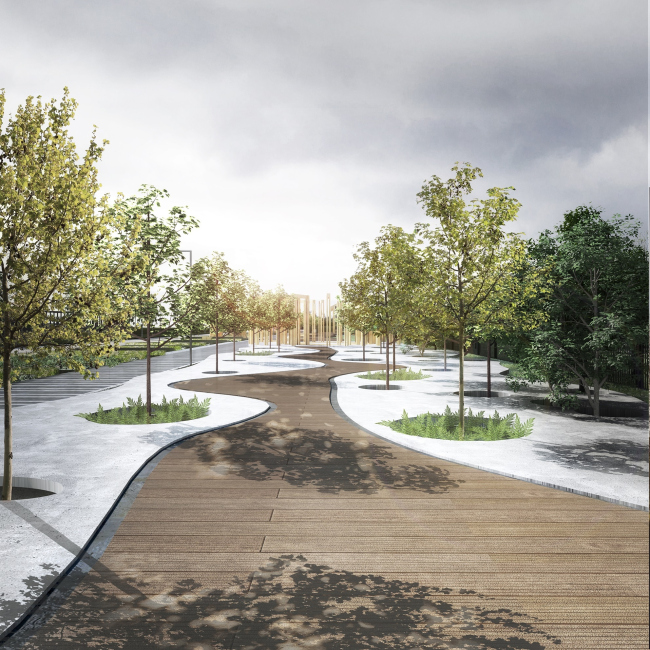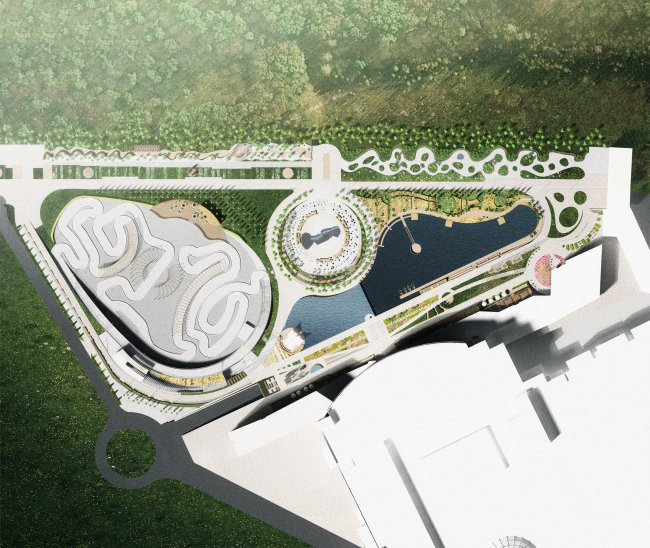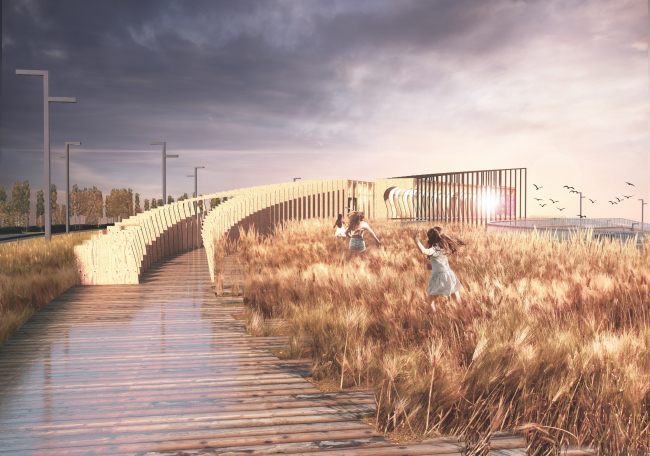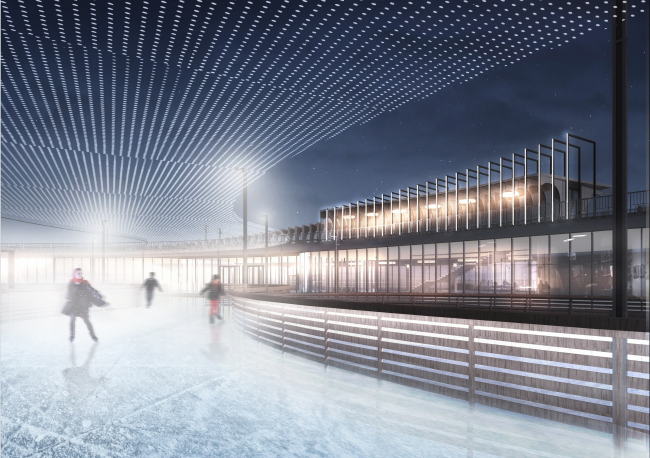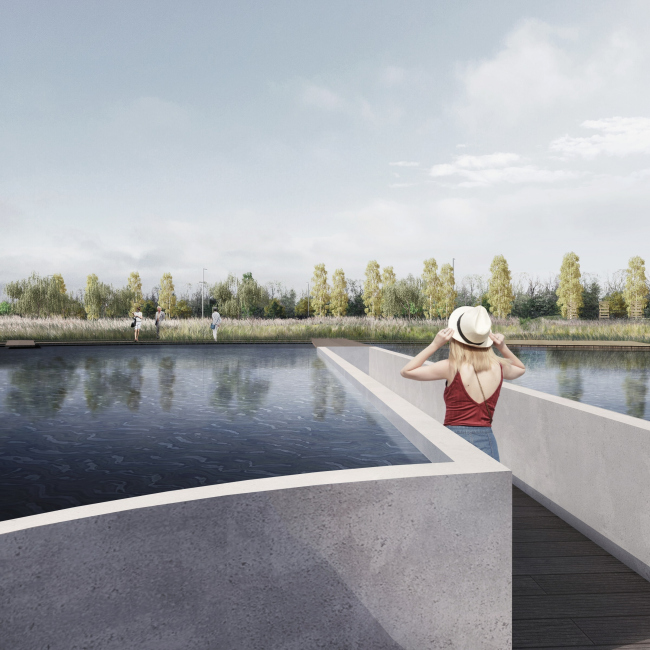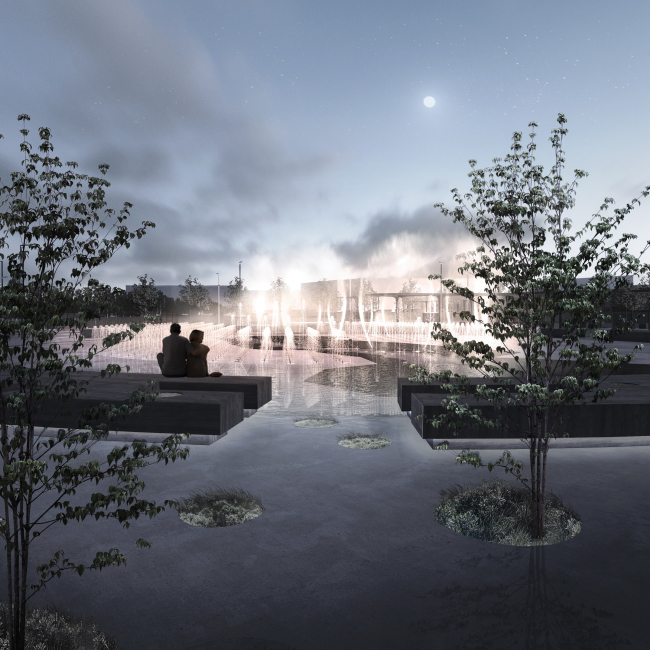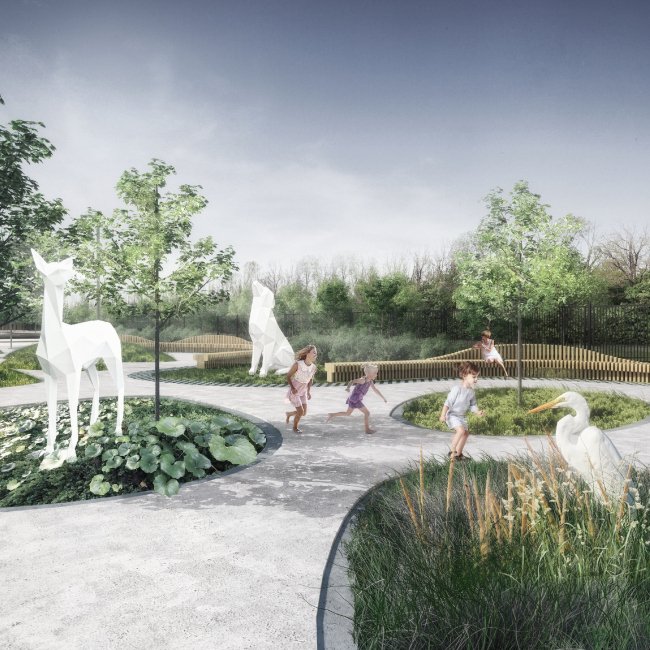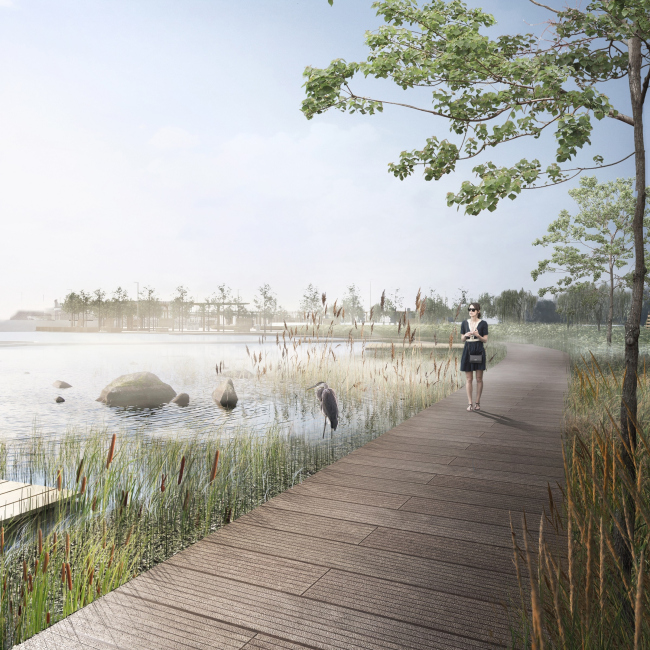|
Published on Archi.ru (https://archi.ru) |
|
| 21.05.2019 | |
|
Hailstorm in Sun City |
|
|
Lara Kopylova |
|
| Studio: | |
| ATOM ga | |
|
The park GRAD (the Russian for “hailstorm” and the Old Russian for “town” – translator’s note), situated next to a namesake shopping mall in Voronezh, is a park of a new type with natural and architectural elements, existing in the stream of leisure time economics. GRAD Park. PromenadeCopyright: © ATOM gaThe project of the park was developed by AM.PROEKTUS and Lap Landscape&Urban Design, which are members of ATOM ga group. This is not their first joint project; these companies have concluded a contract for collaborating on all Russian projects. In Voronezh, the architects won a tender organized by Hamin Group. GRAD ParkCopyright: © ATOM gaThe GRAD park is situated not far away from the Moscow-Voronezh Highway, near the entrance to the city, and serves as a continuation of the shopping and entertainment complex City Park GRAD. Generally speaking, it is a rare occasion when a park is situated immediately next to a shopping mall. But then again, the shopping mall is also far from ordinary. Its owner, Evgeny Khamin, is a man of passion who is trying to introduce innovative urbanist architecture in Voronezh. If he is rebuilding a sports complex, instead of turning it into yet another housing project, he will keep and develop the sports function. If he is building a school, then it will be an advanced one that all the city parents will want their children to go to. He even wrote a book on the developing Voronezh. In the shopping and entertainment center GRAD, the “entertainment” part is more than just an addition to the retail function. It can arguably claim the status of the city’s place of interest in its own right – a concert hall for 2000 spectators, an active city venue where concerts are organized on a weekly basis, as well as an aquarium and a hall with indoor amusement rides – you can spend a whole day with your kids here. The GRAD park, designed by Mark Safronov, develops “leisure time economics” stated in the concept of the shopping mall. It will also contain a few other important “magnets” for attracting the city people – a skating rink, a cross country ski track, a carting, a pond, a safari garden with sculptures, a lecture hall, and an open air concert venue for 10 000 spectators. On one side, the park land borders on the shopping mall, on the other – on a forest, passing through which one can get to the “Sea of Voronezh”, specifically, its cleanest part. GRAD ParkCopyright: © ATOM gaRecently, there’s been a trend for parks to combine natural and architectural elements. A park is perceived as a show: a place for recreation, arts, and entertainment. Among other locations, parks are built near highways – for example, the landscape design company i!melk organized an amusement park along the famous Sunset Strip Boulevard in L.A. The fashion for parks was brought over to Russia by the Dutch, one of the most vivid examples being the “Tyufeleva Roshcha” park that i!melk designed for ZILART. However, it is much more modest than the Voronezh’s GRAD in terms of the number of the city amusement rides. Voronezh’s GRAD combines large-scale sports and entertainment projects suitable for virtually any activity you can possibly think of. It is planned that next to the shopping mall there will be an amusement park and a promenade linked to the lake shore by an eco trail about 3 km long running through the forest. The first part of the project – the promenade – occupies an area of 7.5 hectares, which on the plan looks like a scalene triangle, whose longer cathetus coincides with the wall of the shopping mall, while the main entrance is designed on the sharp angle, next to the entrance to the shopping mall. 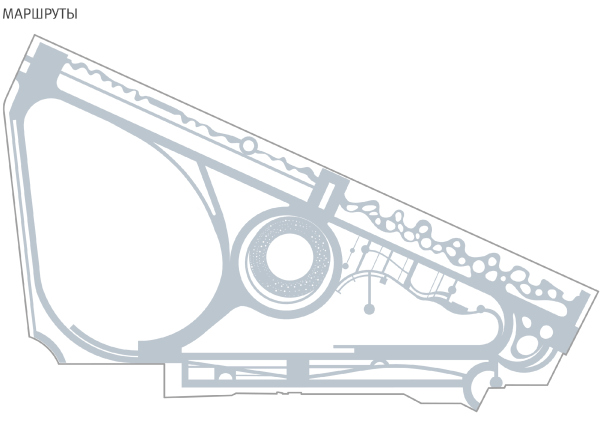 GRAD Park. RoutesCopyright: © ATOM ga GRAD Park. Minor architectural formsCopyright: © ATOM ga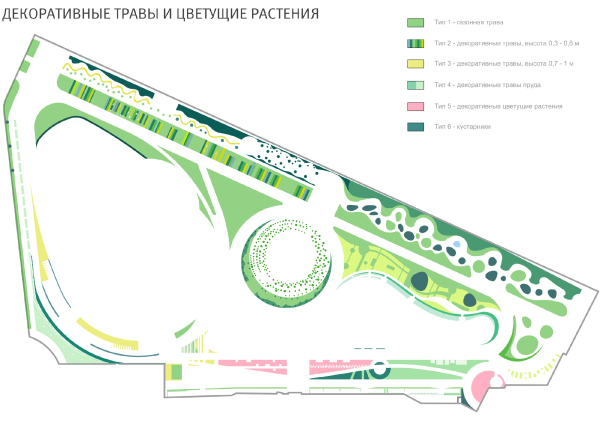 GRAD Park. Decorative grass and blossoming plantsCopyright: © ATOM ga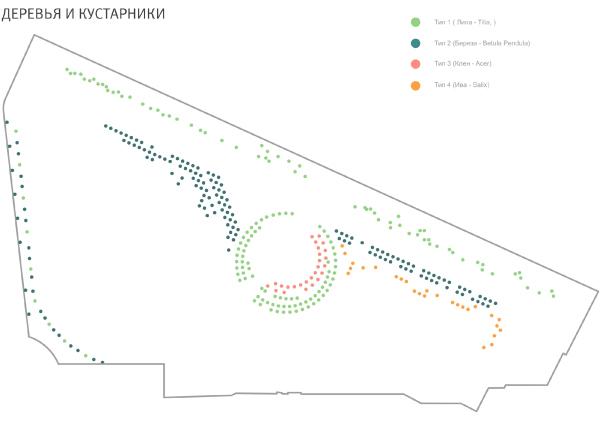 GRAD Park. Trees and shrubsCopyright: © ATOM ga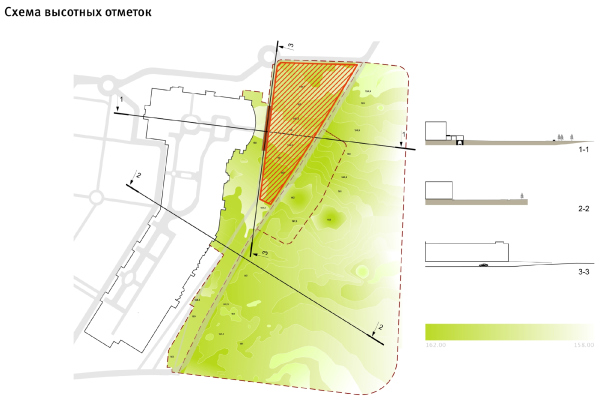 GRAD ParkCopyright: © ATOM gaAs for the promenade park, the architects interpret it as a public area, a system of trails, large and small, chiefly looped and united to form a curious-looking “8” that covers the entire area, being augmented with other paths of different directions and different “degree of winding”. “There are no dead-end trails here, you can be always walking somewhere” – Mark Safronov says. Indeed, everything here is designed in such a way that, when taking a stroll through the park, you could, on the one hand, you could always change your situation and your angle of vision, and, on the other hand, easily be able to get from one part of the park to another. The main constituent parts of the promenade are: a skating rink (to become a concert venue in the summertime); a pond with amusement rides and waterfronts; and, finally, the central circular square with a fountain. The skating rink is divided into the skating area as such and a dance floor with a stage. The building of the rental point, coated by wooden lamellas, marks the entrance to the skating rink; one can also ascend to the bar on the roof from here. GRAD ParkCopyright: © ATOM gaHigher than the skating level, there is a carting; in winter, it turns into a cross-country ski track. In summer, the skating rink turns into an open air concert venue for 10 000 spectators. Originally, the architects proposed to use the European idea of forming the park gradually, in increments, building the first trial version from inexpensive materials, then analyze the visitors’ feedback, then add or remove some things. However, you cannot build either skating rink or concert venue in this way – they require simultaneous construction of their entire infrastructure, and the architects gave up on the “trial period” idea. On the other hand, the skating rink will use the refrigerating units of the shopping mall: in summer they work for the shopping premises, and in winter they stay idle – and now they will be engaged all year round. GRAD Park. Skating rinkCopyright: © ATOM gaThe pond also consists of two parts. The shallow end, 10-15 centimeters deep, will contain fountains and the pavilion of the summer lecture hall. The main deeper part of the pond will contain a quay with row boats, a waterfront with restaurants, and a sunbathing area. The restaurant area will also host a greenhouse with a vegetable garden with edible herbs next to it. On the other side, there is a wild back, overgrown with reeds, where you can sit with a fishing pole, imagining that you are farther away from the city than you actually are. As for the central part of the pond, the architects designed here a “cheating” sightseeing platform: a concrete chamfer, in which the pedestrian path is situated slightly lower than the water level – something like a pedestrian bridge, sunken into the water, yet still dry on the inside. When you walk down such chamfer, you have water splashing slightly lower that your shoulders, you can even touch it and get your fill, as if you were swimming or at least sitting on a boardwalk, dangling your legs – something that you don’t usually get to do in a big city. On the other hand, if you look at the whole thing from the side, it will look as if a person is walking breast-deep in the water – also an amusing sight for the passers-by, or, to be more exact, changing from the habitual viewing point to an unusual or “estranged” one, as Viktoro Shklovsky was wont to say. Probably, this is one of the most unusual “perks” of the park: nowadays, it is expected (and required!) from the architects to propose something unusual, and this role is actively played by bridges, starting from Zaryadye’s hovering bridge. But a bridge that’s partially sunken into the water is something that we probably never saw before. GRAD Park. PondCopyright: © ATOM gaNot far away, there is a summer theater with an installation that can function both as a theater prop and the decoration for the media exhibition. Next to it, there is a dormitory for students, including those who study modern park management. There is a shortage of qualified professionals in this region, and the client provided for an opportunity to train the employees. The summer theater, among other things, can be used as a lecture hall as well. GRAD ParkCopyright: © ATOM gaGRAD Park. SquareCopyright: © ATOM gaThe square will have a musical waters on it, turned, at the client’s request, into an installation with a map of Voronezh, oriented to cardinal points. On the square, in addition to the open public space, there will be a promenade with limes, birches, and maples – something that’s a pretty expensive thing to do nowadays, and the architects had to convince the client that every tree on boulevard counted. “We as landscape architects, had our lives ruined by the Galitsky Park in Krasnodar – Mark Safronov confesses – Many people give it as a fine example but few people realized just how much the budget was overblown”. GRAD Park. RoutesCopyright: © ATOM gaThe appearance of a safari park in the program, as well as the appearance of a zone called “bar code and summer festival” became a measure that to some extent came out of necessity. In the working process it came up that there were three underground water pipes with a diameter of 160 centimeters that provided the entire Voronezh with drinking water. Their protection zone had to be always accessible to emergency services – yes, you can plant flowers there but you cannot build anything more or less substantial upon it. This is why under the stroked area on the plan is the pipes, and nearby is the territory of the flower festival. The plants are temporary and low-maintenance, while the name – “Moon Garden” – originates from the two main colors, green and white. However, the flowers will always be replaceable, and this area will become the most unpredictable-looking in the park. The Safari Park essentially consists of sculptures of animals; these will also be replaced from time to time. The zone of the waterfront is separated from the safari park by tall grass; there are also pedestals with sculptures of animals hidden in it – yet another way to make the park more eventful: walking around, you discover ever new compositions. GRAD Park. PondCopyright: © ATOM gaIt is planned that the second stage of park construction will include adding a farmers market to it – a representative of the typology that is extremely fashionable nowadays in the vein of antiglobalization both in Europe and in Russia (incidentally, Mark Safronov also took part in the competition for the best reconstruction project of Moscow’s Danilovsky Market). So, now Voronezh is also getting a farmers market of its own. The pavement of the square before the marketplace will gradually bleed into the wall and then into the roof, keeping up the rhombus pattern. The main role of the park, however, is still the city-forming one. Voronezh is dynamically developing, lots of construction is going on, and GRAD (the old Rissian for “town”) is named like that for a reason – it must become the nucleus and the starting point for developing the territory, upon which the new suburban town named “Solnechny” (“Sun City”) will be built later on. For large cities, it is very important to be getting such suburban local towns drawing people’s attention from the historical part and providing satellites with fully-fledged public life. And it’s great when such centers are formed well in advance, and not fait accompli. |
|
